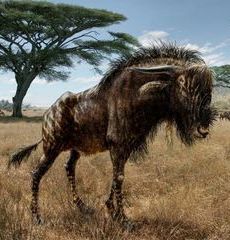Ancient wildebeest used dinosaur-like nose to trumpet across savanna
They lived millions of years apart but an ancient wildebeest and duck-billed dinosaurs had something in common … their noses. The weird nasal structure of the rusingoryx, which roamed Africa’s savannas tens of thousands of years ago, has been revealed after fossils were found in Kenya. Its crescent-shaped protrusion on the top of its head was unlike anything on any other mammal, past or present. Instead, it resembled the head crests of a group of duck-billed dinosaurs called hadrosaurs, researchers say.
The nasal dome is a completely new structure for mammals — it doesn’t look like anything you could see in an animal that’s alive today
Researcher Haley O'Brien
The fossils of rusingoryx, about the size of its close cousin the wildebeest, date from about 55,000 to 75,000 years ago. Its hollow nasal structure may have enabled the horned, hoofed grass-eater to produce a low trumpeting sound to communicate over long distances with others in its herd, Ohio University paleontologist Haley O'Brien said. “This structure was incredibly surprising,” O'Brien said. “To see a hollow nasal crest outside of dinosaurs and in a mammal that lived so recently is very bizarre.” Lambeosaurus and corythosaurus, hadrosaurs with similar nasal structures, lived about 75 million years ago.
Vocalizations can alert predators, and moving their calls into a new frequency could have made communication safer.
Haley O'Brien

Rusingoryx